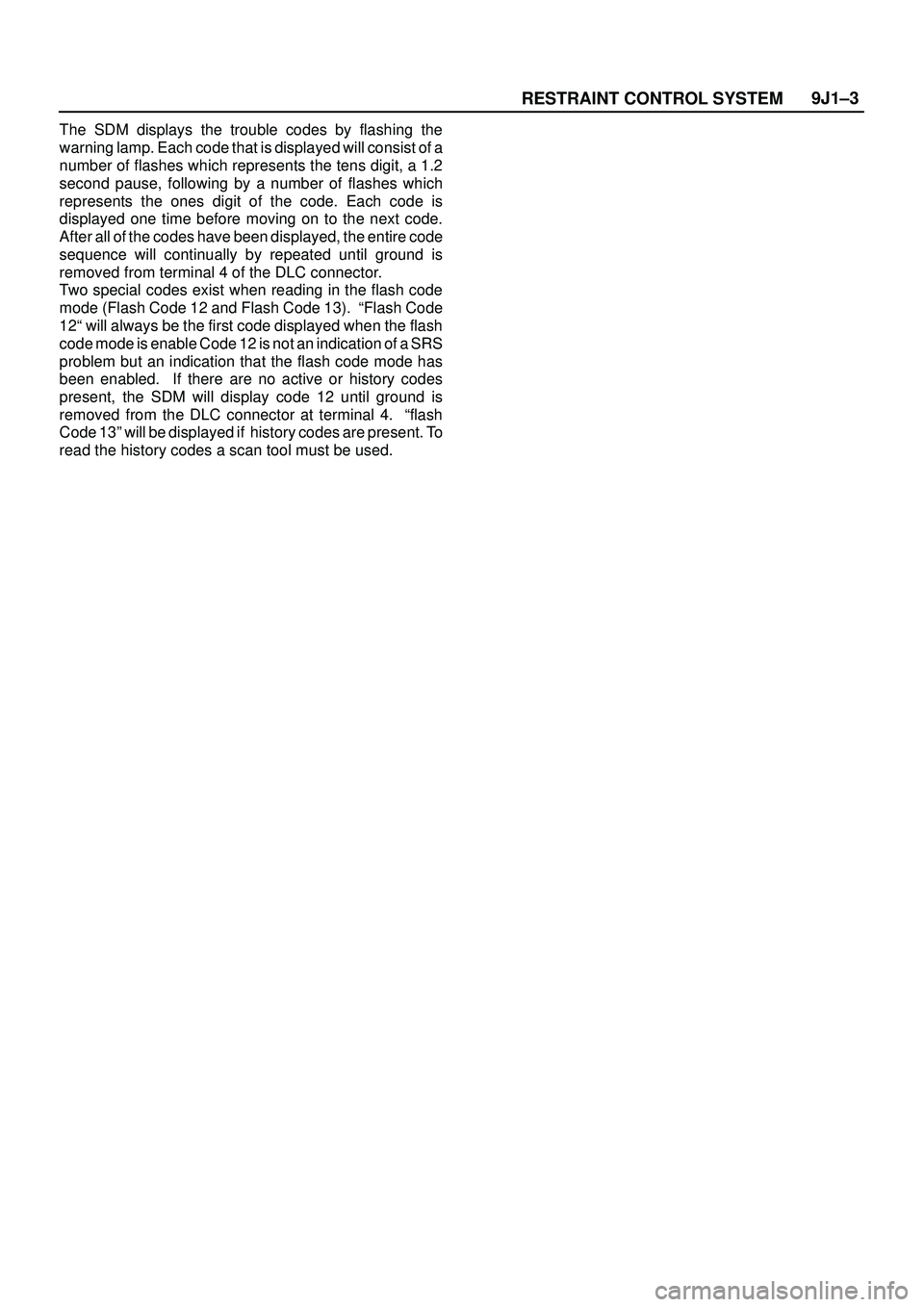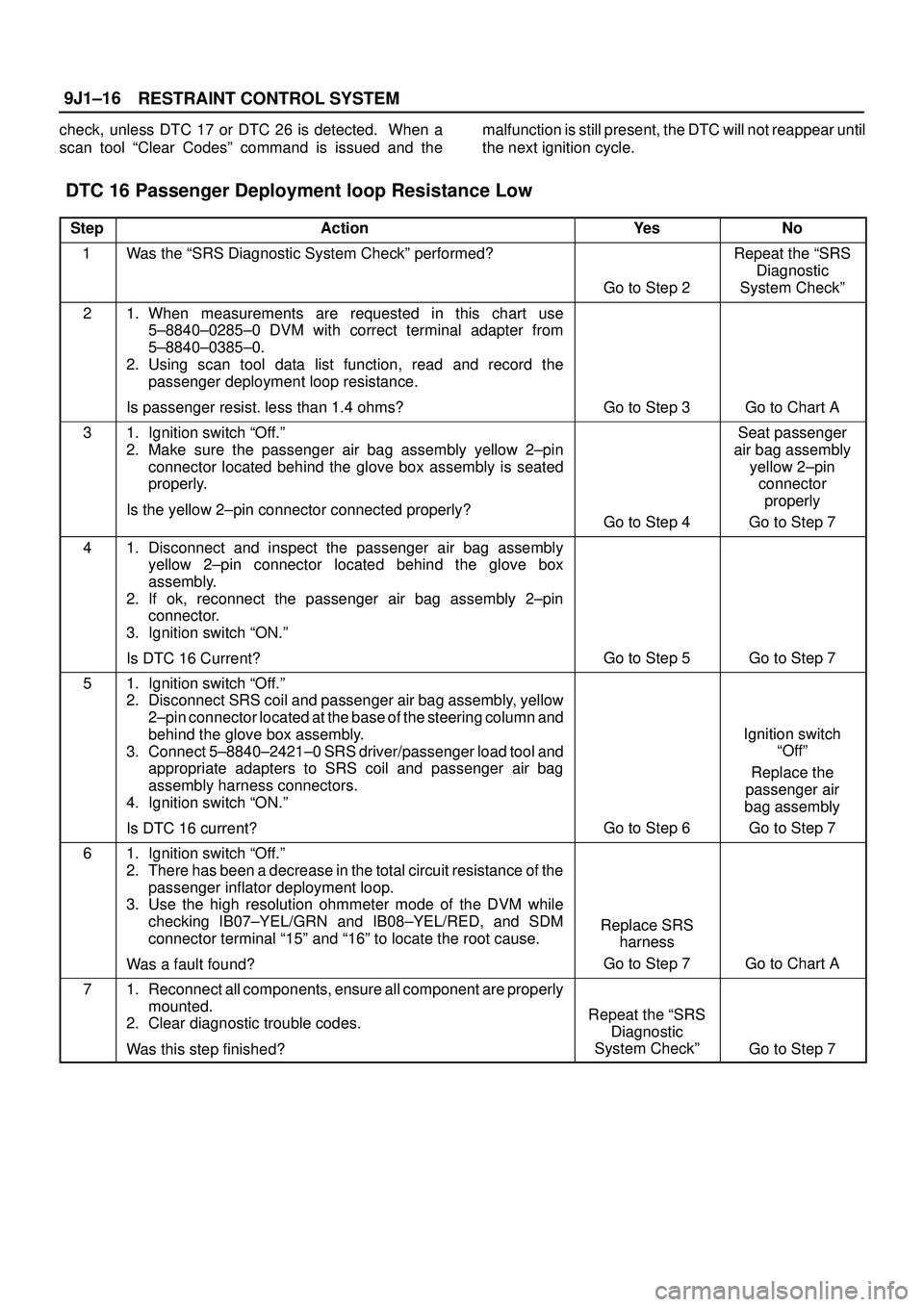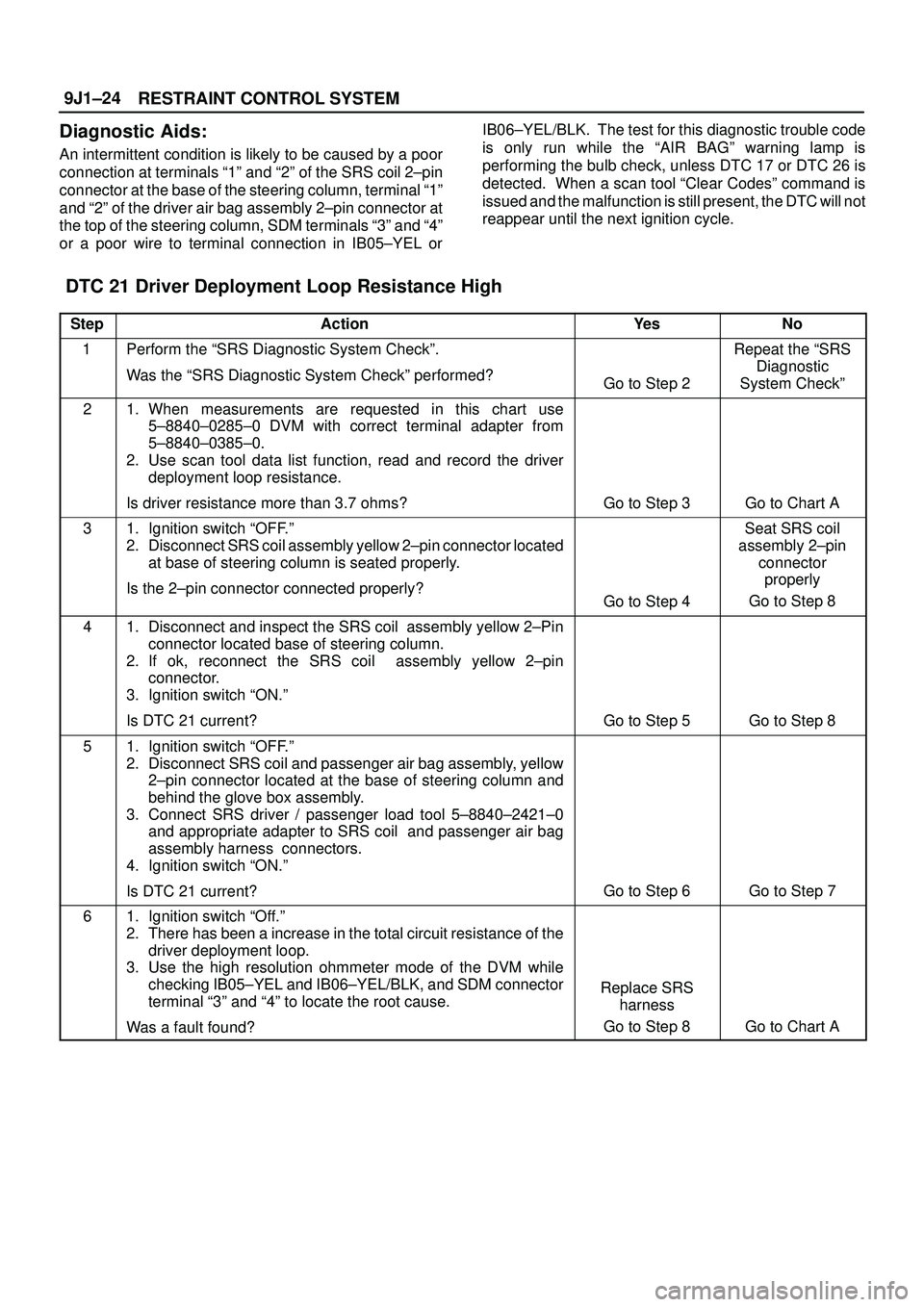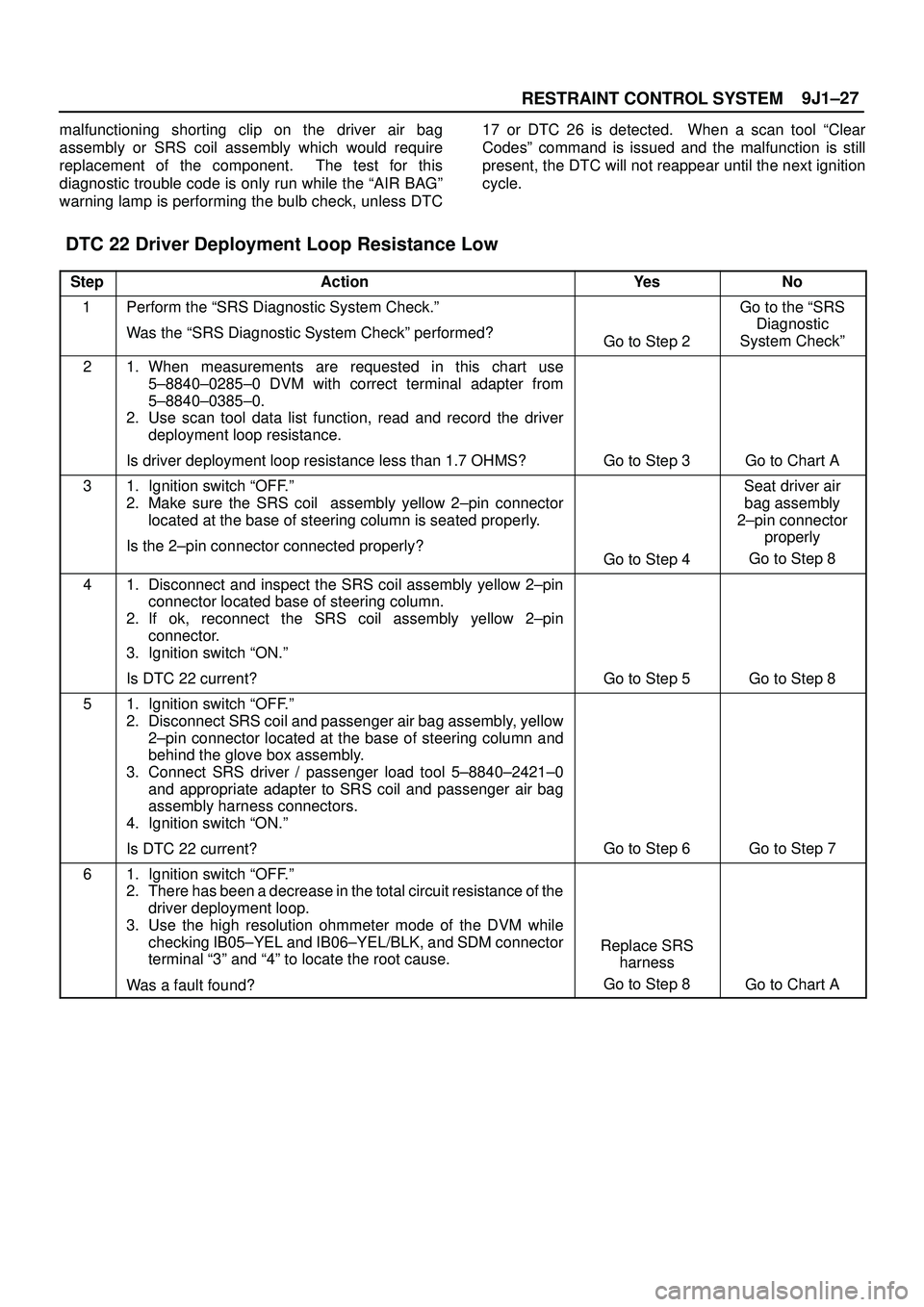1998 ISUZU TROOPER ECO mode
[x] Cancel search: ECO modePage 3489 of 3573

RESTRAINT CONTROL SYSTEM 9J1±2
Diagnostic Information
CAUTION: When fasteners are removed, always
reinstall them at the same location from which they
were removed. if a fastener needs to be replaced, use
the correct part number fastener for that application.
if the correct part number fastener is not available, a
fastener of equal size and strength (or stronger) may
be used. fasteners that are not reused, and those
requiring thread locking compound will be called
out. the correct torque value must be used when
installing fasteners that require it. if the above
conditions are not followed, parts or system damage
could result.
Diagnostic Procedures
WARNING: T O AV O I D D E P L O Y M E N T W H E N
TROUBLESHOOTING THE SRS, DO NOT USE
ELECTRICAL TEST EQUIPMENT SUCH AS A
BATTERY±POWERED OR AC±POWERED
VOLTMETER, OHMMETER, ETC., OR ANY TYPE OF
ELECTRICAL EQUIPMENT OTHER THAN THAT
SPECIFIED IN THIS MANUAL. DO NOT USE A NON
POWERED, PROBE±TYPE TESTER.
INSTRUCTIONS IN THIS MANUAL MUST BE
FOLLOWED CAREFULLY, OTHERWISE PERSONAL
INJURY MAY RESULT.
The diagnostic procedures used in this section are
designed to aid in finding and repairing SRS problems.
Outlined below are the steps to find and repair SRS
problems quickly and effectively. Failure to carefully
follow these procedures may result in extended
diagnostic time, incorrect diagnosis and incorrect parts
replacement.
1.Perform The ªSRS Diagnostic System Checkº.
The ªSRS Diagnostic System Checkº should always
be the starting point of any SRS diagnostics. The
ªSRS Diagnostic System Checkº checks for proper
ªAIR BAGº warning lamp operation and checks for
SRS trouble codes using both ªFlash Codeº and
ªScan Toolº Methods.
2.Refer To The Proper Diagnostic Chart As Directed
By The ªSRS Diagnostic System Checkº.
The ªSRS Diagnostic System Checkº will lead you to
the correct chart to diagnose any SRS problems.
Bypassing these procedures may result in extended
diagnostic time, incorrect diagnosis and incorrect
parts replacement.
3.Repeat The ªSRS Diagnostic System Checkº
After Any Repair Or Diagnostic Procedures Have
Been Performed.
Preforming the ªSRS Diagnostic System Checkº after
all repair or diagnostic procedures will assure that the
repair has been made correctly and that no other
conditions exist.
Diagnostic Codes
The Sensing and Diagnostic Module (SDM) maintains a
history record of all diagnostic codes that have beendetected since the SRS codes were last cleared during
service.
1. Active Codes Ð Faults that are presently detected
this ignition cycle. Active codes are stored in RAM
(Random Access Memory).
2. History Codes Ð All faults detected since the last
time the history fault memory was cleared. History
codes are stored in EEPROM. (Electronically
Erasable Programmable Read only Memory)
How To Read Trouble Codes
All codes (Active and history) can be read (or cleared) by
using a scan tool or equivalent.
If a PDT is not available, have the vehicle serviced by
ISUZU dealer.
How To Clear Trouble Codes
Trouble codes can only be cleared by using a Scan Tool.
If a ªscan toolº is not available then inform the owner of the
stored codes and suggest that the codes are cleared
upon the next visit to an Isuzu dealership.
Scan Tool Diagnostics
A scan tool can be used to read current and history codes
and to clear all history codes after a repair is complete.
The scan tool must be updated to communicate with the
SRS through a memory card or a manufacturer's update
before it can be used for SRS diagnostics. To use the
scan tool, connect it to the DLC connector and turn the
ignition switch ªONº. Then follow the manufacturer's
directions for communication with the SRS. The scan tool
reads serial data from the SDM ªSerial Dataº output
(terminal 24) to the DLC connector (terminal 9).
Basic Knowledge Required
Before using this section of the Service Manual, there is
some basic knowledge which will be required. Without
this knowledge, you will have trouble using the diagnostic
procedures in this section. Use care to prevent harm or
unwanted deployment. Read all cautions in the service
manual and on warning labels attached to SRS
components.
Basic Electrical Circuits
You should understand the basic theory of electricity
including series and parallel circuits, and understand the
voltage drops across series resistors. You should know
the meaning of voltage (volts), current (amps), and
resistance (ohms). You should understand what happens
in a circuit with an open or a shorted wire. You should be
able to read and understand a wiring diagram.
ªFlash Codeº Diagnostics
Flash code diagnostics can be used to read active codes
and to determine if history codes are present but cannot
be used to clear codes or read history codes. Flash code
diagnostics is enabled by grounding by terminal 4
shorting to terminal 13 of the DLC connector with the
ignition switch ªONº. Grounding terminal 4 of the DLC
connector pulls the ªDiagnostics Requestº input (Terminal
1) of the SDM low and signals the SDM to enter the flash
code diagnostic display mode.
Page 3490 of 3573

9J1±3
RESTRAINT CONTROL SYSTEM
The SDM displays the trouble codes by flashing the
warning lamp. Each code that is displayed will consist of a
number of flashes which represents the tens digit, a 1.2
second pause, following by a number of flashes which
represents the ones digit of the code. Each code is
displayed one time before moving on to the next code.
After all of the codes have been displayed, the entire code
sequence will continually by repeated until ground is
removed from terminal 4 of the DLC connector.
Two special codes exist when reading in the flash code
mode (Flash Code 12 and Flash Code 13). ªFlash Code
12ª will always be the first code displayed when the flash
code mode is enable Code 12 is not an indication of a SRS
problem but an indication that the flash code mode has
been enabled. If there are no active or history codes
present, the SDM will display code 12 until ground is
removed from the DLC connector at terminal 4. ªflash
Code 13º will be displayed if history codes are present. To
read the history codes a scan tool must be used.
Page 3501 of 3573

RESTRAINT CONTROL SYSTEM 9J1±14
warning lamp is performing the bulb check, unless DTC
17 or DTC 26 is detected. When a scan tool ªClear
Codesº command is issued and the malfunction is stillpresent, the DTC will not reappear until the next ignition
cycle.
DTC 15 Passenger Deployment loop Resistance High
StepActionYe sNo
1Was the ªSRS Diagnostic System Checkº Performed?
Go to Step 2
Go to The ªSRS
Diagnostic
System Checkº
21. When measurements are requested in this chart use
5±8840±0285±0 DVM with correct terminal adapter from
5±8840±0385±0.
2. Use scan tool data list function, read and record the passenger
deployment loop resistance.
Is passenger resist. more than 2.9 ohms?
Go to Step 3Go to Chart A
31. Ignition switch ªOff.º
2. Make sure the passenger air bag assembly yellow 2±pin
connector located behind the glove box assembly is seated
properly.
Is the yellow 2±pin connector connected properly?
Go to Step 4
Seat passenger
Air Bag assembly
yellow 2±pin
connector
properly
Go to Step 7
41. Disconnect and inspect the passenger air bag assembly
yellow 2±pin connector located behind the glove box
assembly.
2. If ok, reconnect the passenger air bag assembly 2±pin
connector.
3. Ignition switch ªON.º
Is DTC 15 current?
Go to Step 5Go to Step 7
51. Ignition switch ªOff.º
2. Disconnect SRS coil and passenger air bag assembly, yellow
2±pin connector located at the base of the steering column and
behind the glove box assembly.
3. Connect 5±8840±2421±0 SRS driver / passenger load tool
and appropriate adapters to SRS coil and passenger air bag
assembly harness connectors.
4. Ignition switch ªON.º
Is DTC 15 Current?
Go to Step 6
Ignition switch
ªOffº
Replace the
passenger air
bag assembly
Go to Step 7
61. Ignition switch ªOff.º
2. There has been an increase in the total circuit resistance of the
passenger inflator deployment loop.
3. Use the high resolution ohmmeter mode of the DVM while
checking IB07±YEL/GRN and IB08±YEL/RED, and SDM
connector terminal ª15º and ª16º to locate the root cause.
Was a fault found?
Replace SRS
harness
Go to Step 7
Go to Chart A
71. Reconnect all components ensure all component are properly
mounted.
2. Clear diagnostic trouble codes.
Was This step finished?
Repeat the ªSRS
Diagnostic
System Checkº
Go to Step 7
Page 3503 of 3573

RESTRAINT CONTROL SYSTEM 9J1±16
check, unless DTC 17 or DTC 26 is detected. When a
scan tool ªClear Codesº command is issued and themalfunction is still present, the DTC will not reappear until
the next ignition cycle.
DTC 16 Passenger Deployment loop Resistance Low
StepActionYe sNo
1Was the ªSRS Diagnostic System Checkº performed?
Go to Step 2
Repeat the ªSRS
Diagnostic
System Checkº
21. When measurements are requested in this chart use
5±8840±0285±0 DVM with correct terminal adapter from
5±8840±0385±0.
2. Using scan tool data list function, read and record the
passenger deployment loop resistance.
Is passenger resist. less than 1.4 ohms?
Go to Step 3Go to Chart A
31. Ignition switch ªOff.º
2. Make sure the passenger air bag assembly yellow 2±pin
connector located behind the glove box assembly is seated
properly.
Is the yellow 2±pin connector connected properly?
Go to Step 4
Seat passenger
air bag assembly
yellow 2±pin
connector
properly
Go to Step 7
41. Disconnect and inspect the passenger air bag assembly
yellow 2±pin connector located behind the glove box
assembly.
2. If ok, reconnect the passenger air bag assembly 2±pin
connector.
3. Ignition switch ªON.º
Is DTC 16 Current?
Go to Step 5Go to Step 7
51. Ignition switch ªOff.º
2. Disconnect SRS coil and passenger air bag assembly, yellow
2±pin connector located at the base of the steering column and
behind the glove box assembly.
3. Connect 5±8840±2421±0 SRS driver/passenger load tool and
appropriate adapters to SRS coil and passenger air bag
assembly harness connectors.
4. Ignition switch ªON.º
Is DTC 16 current?
Go to Step 6
Ignition switch
ªOffº
Replace the
passenger air
bag assembly
Go to Step 7
61. Ignition switch ªOff.º
2. There has been a decrease in the total circuit resistance of the
passenger inflator deployment loop.
3. Use the high resolution ohmmeter mode of the DVM while
checking IB07±YEL/GRN and IB08±YEL/RED, and SDM
connector terminal ª15º and ª16º to locate the root cause.
Was a fault found?
Replace SRS
harness
Go to Step 7
Go to Chart A
71. Reconnect all components, ensure all component are properly
mounted.
2. Clear diagnostic trouble codes.
Was this step finished?
Repeat the ªSRS
Diagnostic
System Checkº
Go to Step 7
Page 3505 of 3573

RESTRAINT CONTROL SYSTEM 9J1±18
DTC 17 Passenger Deployment Loop Open
StepActionYe sNo
1Was the ªSRS Diagnostic System Checkº performed?
Go to Step 2
Go to the ªSRS
Diagnostic
System Checkº
21. When measurements are requested in this chart use
5±8840±0285±0 DVM with correct terminal adapter from
5±8840±0385±0.
2. Using scan tool data list function, read and record the
passenger differential voltage.
Is passenger VDIF 0.425 volts or more?
Go to Step 3Go to Chart A
31. Ignition switch ªOFFº.
2. Make sure the passenger air bag assembly yellow 2±pin
connector located behind the glove box assembly is seated
properly.
Is the yellow 2±pin connector connected properly?
Go to Step 4
Seat passenger
air bag assembly
yellow 2±pin
connector
properly
Go to Step 7
41. Disconnect and inspect the passenger air bag assembly
yellow 2±pin connector located behind the glove box
assembly.
2. If ok, reconnect the passenger air bag assembly 2±pin
connector.
3. Ignition switch ªONº.
Is DTC 17 current?
Go to Step 5Go to Step 7
51. Ignition switch ªOff.º
2. Disconnect SRS coil and passenger air bag assembly, yellow
2±pin connector located at the base of the steering column and
behind the glove box assembly.
3. Connect 5±8840±2421±0 SRS driver / passenger load tool
and appropriate adapters to SRS coil and passenger air bag
assembly harness connectors.
4. Ignition switch ªON.º
Is DTC 17 current?
Go to Step 6
Ignition switch
ªOffº
Replace the
passenger air
bag assembly
Go to Step 7
61. Ignition switch ªOff.º
2. There has been an open circuit resistance in the passenger
deployment loop.
3. Use the high resolution ohmmeter mode of the DVM while
checking IB07±YEL/GRN and IB08±YEL/RED, and SDM
connector terminal ª15º and ª16º to locate the root cause.
Was a fault found?
Replace SRS
harness
Go to Step 7
Go to Chart A
71. Reconnect all components ensure all component are properly
mounted.
2. Clear diagnostic trouble codes.
Was this step finished?
Go to the ªSRS
Diagnostic
System Checkº
Go to Step 7
Page 3511 of 3573

RESTRAINT CONTROL SYSTEM 9J1±24
Diagnostic Aids:
An intermittent condition is likely to be caused by a poor
connection at terminals ª1º and ª2º of the SRS coil 2±pin
connector at the base of the steering column, terminal ª1º
and ª2º of the driver air bag assembly 2±pin connector at
the top of the steering column, SDM terminals ª3º and ª4º
or a poor wire to terminal connection in IB05±YEL orIB06±YEL/BLK. The test for this diagnostic trouble code
is only run while the ªAIR BAGº warning lamp is
performing the bulb check, unless DTC 17 or DTC 26 is
detected. When a scan tool ªClear Codesº command is
issued and the malfunction is still present, the DTC will not
reappear until the next ignition cycle.
DTC 21 Driver Deployment Loop Resistance High
StepActionYe sNo
1Perform the ªSRS Diagnostic System Checkº.
Was the ªSRS Diagnostic System Checkº performed?
Go to Step 2
Repeat the ªSRS
Diagnostic
System Checkº
21. When measurements are requested in this chart use
5±8840±0285±0 DVM with correct terminal adapter from
5±8840±0385±0.
2. Use scan tool data list function, read and record the driver
deployment loop resistance.
Is driver resistance more than 3.7 ohms?
Go to Step 3Go to Chart A
31. Ignition switch ªOFF.º
2. Disconnect SRS coil assembly yellow 2±pin connector located
at base of steering column is seated properly.
Is the 2±pin connector connected properly?
Go to Step 4
Seat SRS coil
assembly 2±pin
connector
properly
Go to Step 8
41. Disconnect and inspect the SRS coil assembly yellow 2±Pin
connector located base of steering column.
2. If ok, reconnect the SRS coil assembly yellow 2±pin
connector.
3. Ignition switch ªON.º
Is DTC 21 current?
Go to Step 5Go to Step 8
51. Ignition switch ªOFF.º
2. Disconnect SRS coil and passenger air bag assembly, yellow
2±pin connector located at the base of steering column and
behind the glove box assembly.
3. Connect SRS driver / passenger load tool 5±8840±2421±0
and appropriate adapter to SRS coil and passenger air bag
assembly harness connectors.
4. Ignition switch ªON.º
Is DTC 21 current?
Go to Step 6Go to Step 7
61. Ignition switch ªOff.º
2. There has been a increase in the total circuit resistance of the
driver deployment loop.
3. Use the high resolution ohmmeter mode of the DVM while
checking IB05±YEL and IB06±YEL/BLK, and SDM connector
terminal ª3º and ª4º to locate the root cause.
Was a fault found?
Replace SRS
harness
Go to Step 8
Go to Chart A
Page 3514 of 3573

9J1±27
RESTRAINT CONTROL SYSTEM
malfunctioning shorting clip on the driver air bag
assembly or SRS coil assembly which would require
replacement of the component. The test for this
diagnostic trouble code is only run while the ªAIR BAGº
warning lamp is performing the bulb check, unless DTC17 or DTC 26 is detected. When a scan tool ªClear
Codesº command is issued and the malfunction is still
present, the DTC will not reappear until the next ignition
cycle.
DTC 22 Driver Deployment Loop Resistance Low
StepActionYe sNo
1Perform the ªSRS Diagnostic System Check.º
Was the ªSRS Diagnostic System Checkº performed?
Go to Step 2
Go to the ªSRS
Diagnostic
System Checkº
21. When measurements are requested in this chart use
5±8840±0285±0 DVM with correct terminal adapter from
5±8840±0385±0.
2. Use scan tool data list function, read and record the driver
deployment loop resistance.
Is driver deployment loop resistance less than 1.7 OHMS?
Go to Step 3Go to Chart A
31. Ignition switch ªOFF.º
2. Make sure the SRS coil assembly yellow 2±pin connector
located at the base of steering column is seated properly.
Is the 2±pin connector connected properly?
Go to Step 4
Seat driver air
bag assembly
2±pin connector
properly
Go to Step 8
41. Disconnect and inspect the SRS coil assembly yellow 2±pin
connector located base of steering column.
2. If ok, reconnect the SRS coil assembly yellow 2±pin
connector.
3. Ignition switch ªON.º
Is DTC 22 current?
Go to Step 5Go to Step 8
51. Ignition switch ªOFF.º
2. Disconnect SRS coil and passenger air bag assembly, yellow
2±pin connector located at the base of steering column and
behind the glove box assembly.
3. Connect SRS driver / passenger load tool 5±8840±2421±0
and appropriate adapter to SRS coil and passenger air bag
assembly harness connectors.
4. Ignition switch ªON.º
Is DTC 22 current?
Go to Step 6Go to Step 7
61. Ignition switch ªOFF.º
2. There has been a decrease in the total circuit resistance of the
driver deployment loop.
3. Use the high resolution ohmmeter mode of the DVM while
checking IB05±YEL and IB06±YEL/BLK, and SDM connector
terminal ª3º and ª4º to locate the root cause.
Was a fault found?
Replace SRS
harness
Go to Step 8
Go to Chart A
Page 3521 of 3573

RESTRAINT CONTROL SYSTEM 9J1±34
DTC 26 Driver Deployment Loop Open
StepActionYe sNo
1Was the ªSRS Diagnostic System Checkº performed?
Go to Step 2
Go to the ªSRS
Diagnostic
System Checkº
21. When measurements are requested in this chart use
5±8840±0285±0 DVM with correct terminal adapter from
5±8840±0385±0.
2. Use scan tool data list function, read and record the driver
differential voltage.
Is driver VDIF more than 4.25 volts?
Go to Step 3Go to Chart A
31. Ignition switch ªOFF.º
2. Make sure the SRS coil assembly yellow 2±pin connector
located at the base of steering column is seated properly.
Is the yellow 2±pin connector connected properly?
Go to Step 4
Seat driver air
bag assembly
2±pin connector
Go to Step 8
41. Disconnect and inspect the SRS coil assembly yellow 2±pin
connector located base of steering column.
2. If ok, reconnect the SRS coil assembly yellow 2±pin
connector.
3. Ignition switch ªON.º
Is DTC 26 current?
Go to Step 5Go to Step 8
51. Ignition switch ªOFFº.
2. Disconnect SRS coil and passenger air bag assembly, yellow
2±pin connectors located at the base of steering column and
behind the glove box assembly.
3. Connect SRS driver/passenger load tool 5±8840±2421±0 and
appropriate adapter to SRS coil and passenger air bag
assembly harness connectors.
4. Ignition switch ªON.º
Is DTC 26 current?
Go to Step 6Go to Step 7
61. Ignition switch ªOFF.º
2. There has been an open circuit in the driver inflator
deployment loop.
3. Use the high resolution ohmmeter mode of the DVM while
checking IB05±YEL and IB06±YEL/BLK, and SDM connector
terminal ª3º and ª4º to locate the root cause.
Was a fault found?
Replace SRS
harness
Go to Step 8
Go to Chart A
71. Ignition switch ªOFF.º
2. Disconnect SRS driver / passenger load tool from SRS coil
assembly harness connector.
3. Connect SRS driver / passenger load tool 5±8840±2421±0 on
steering column 2±pin connector.
4. Reconnect SRS coil assembly harness connector at the base
of steering column.
5. Ignition switch ªON.º
Is DTC 26 current?
Ignition switch
ªOFFº
Replace SRS coil
assembly
Go to Step 8Ignition switch
ªOFFº
Replace driver air
bag assembly
Go to Step 8
81. Reconnect all components ensure all component are properly
mounted.
2. Clear diagnostic trouble codes.
Was this step finished?
Repeat the ªSRS
Diagnostic
System Checkº
Go to Step 8